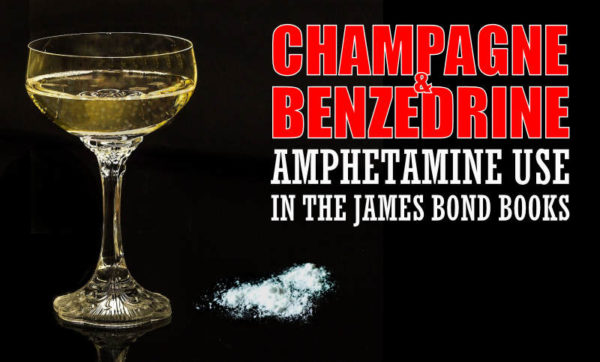While 007’s heavy drinking and smoking made the transition to the silver screen, so far his occasional amphetamine use has not.

In Daniel Craig’s debut as 007 Le Chiffre sometimes draws a breath from a metal inhaler. Apart from the material from which it is made, the design of the inhaler in Casino Royale precisely matches the plastic devices carried by asthmatics. And from the manner in which Le Chiffre uses it there is not even a hint that it might be anything but an asthma inhaler. The inhaler is briefly a focal point when Bond and Felix find it unattended on a table during a break from the poker. Surreptitiously Bond attaches a tracking device.
Although the film makes no attempt to explain the inhaler, it is clearly a nod to Ian Fleming. In his novel on which the film is based, Le Chiffre’s file notes his frequent use of a Benzedrine inhaler.
In this article we’ll look at what Benzedrine is, which may suggest why Le Chiffre uses it. And we’ll also delve into Bond’s occasional reliance on Benzedrine on a mission. Just as big screen Bond is yet to eat scrambled eggs, or introduce us to May, his housekeeper, so far we haven’t seen him reach for any pharmaceutical assistance in a film.
A brief history of Benzedrine
Benzedrine is the brand name of the amphetamine benzyl-methyl carbinamine. In the late nineteenth century it became the first ever amphetamine to be synthesized but its stimulant effects were unknown until 1927.
In 1934 American pharmaceutical company Smith, Kline and French (now part of GlaxoSmithKline) began marketing Benzedrine as a bronchodilator for treating asthma, nasal congestion, or cold symptoms. The medication came in the form of a cotton plug soaked in Benzedrine sulphate and was encased in a small, metal inhaler device. Users would inhale the vapours through the mouth or nose to relieve congestion.
Non-medical use
It didn’t take long for Benzedrine to be used for its effects as a stimulant. By removing the cotton plug and ingesting its contents users experienced a more intense effect.
By the late 1930s Benzedrine was also available in pill form. That made it easier to prescribe for a range of conditions, including narcolepsy and for weight loss. They were more convenient and dosages could be controlled more precisely. The tablets became popular for non-medical use, including by students who would use it to stay up and study. Some users dissolved the tablets to consume as a liquid to mask the drug’s bitter taste.
World War II became the driving force behind the widespread adoption of Benzedrine. After it was found German aircrews shot down in the UK during the Blitz were issued with tablets containing methamphetamine, the Royal Air Force began issuing Benzedrine to aircrews. It allowed them to remain alert on long missions and to hold off exhaustion.
Benzedrine was soon an essential tool for soldiers, pilots, and sailors in the British and other Allied forces. After the war this influenced the substance’s transition to civilian life. It laid the groundwork for Benzedrine’s acceptance in cultural and recreational spheres.
It is now known that the German armed forces had been issued with methamphetamine since at least 1938. It is also a large part of why Germany’s Blitzkrieg warfare was so effective in the invasion of Poland in 1939, then Denmark, Norway, Holland, Belgium, and France the following year. Nazi troops would advance without rest for days, although the negative health effects of large doses of methamphetamine soon became apparent.
Benzedrine post-war
The post-war era saw a surge in motor racing’s popularity, with drivers pushing themselves and their machines to the limit. Particularly in endurance events it was not uncommon for drivers to use Benzedrine to gain a competitive edge. It wasn’t only used in motorsports though.
Among writers, artists, and intellectuals, “pep pills” or “bennies” became known for their ability to prolong periods of focused creativity and productivity. Beat Generation novelist and poet, Jack Kerouac, used Benzedrine while writing On the Road. The book’s spontaneous, stream-of-consciousness style is thought to be due to Kerouac’s use of the drug.
WH Auden was also known to use Benzedrine to maintain his rigorous writing schedule. He referred to the drug as a “labour-saving device” in the creative process. French existentialist philosopher and playwright Jean-Paul Sartre reportedly used stimulants, including Benzedrine. Charlie Parker and William Burroughs used it, and gonzo journalist Hunter S Thompson was supposed to have been a fan before he turned to cocaine. And Judy Garland’s struggles with addiction are well-documented but it is suggested she was introduced to amphetamines as a young actress to control her weight and sustain her energy for performances.
Perhaps less well known is the use of stimulants among scientists and mathematicians. High-pressure environments, demanding intellectual work, and the pursuit of ground-breaking discoveries led some to substances that promised increased focus, stamina, and productivity.
One of the most famous cases of stimulant use among scientists involves Paul Erdős, a prolific Hungarian mathematician known for his extraordinary contributions to various fields of mathematics. Erdős’s use of amphetamines, including Benzedrine, has been well-documented and is often mentioned in discussions about his eccentric lifestyle and remarkable productivity.
His dependence on amphetamines was so well-known that, according to lore, he once bet a friend that he could stop taking them for a month. Erdős won the bet but remarked that mathematics had been set back by a month as a result, underscoring his belief in the efficacy of these substances for his work.
Regulation
By the 1960s recreational amphetamine use was widespread in the United States. While less prevalent in Britain, amphetamines were the drug of choice among mods and rockers, which they nicknamed dexies (Dexedrine), black bombers (Durophet) and Purple Hearts (Drinamyl).
The effects of amphetamines on addiction, abuse, and adverse health were understood by now. In the UK amphetamines could only be obtained by prescription after 1964. After providing amphetamine to US servicemen fighting in Vietnam, the introduction of the Drug Abuse Regulation and Control Act of 1970 imposed tight controls on amphetamines.
Today, prescription amphetamines are closely regulated in most counties and are prescribed for specific conditions such as ADHD and narcolepsy. In Japan, where they experienced an amphetamine epidemic in the 1950s, amphetamines remain banned outright.
Benzedrine in the Bond books
While Le Chiffre’s file in Casino Royale noted that he was a frequent Benzedrine user, Fleming only mentions him using the inhaler on a couple of occasions while at the baccarat table:
He slowly removed one thick hand from the table and slipped it into the pocket of his dinner-jacket. The hand came out holding a small metal cylinder with a cap which Le Chiffre unscrewed. He inserted the nozzle of the cylinder, with an obscene deliberation, twice into each black nostril in turn, and luxuriously inhaled the benzedrine vapour.
Later, at a moment of high tension, he uses it again:
The spectators craned forward. Le Chiffre hit the shoe with a flat-handed slap that made it rattle. As an afterthought he took out his benzedrine inhaler and sucked the vapour up his nose.
‘Filthy brute,’ said Mrs Du Pont on Bond’s left.
In 1952 when Ian Fleming wrote Casino Royale the use of Benzedrine and other amphetamines was clearly much more acceptable. It’s unclear whether Mrs Du Pont disapproved of Le Chiffre because of his Benzedrine use, or the manner in which he inhaled.
There is no evidence either way to say Fleming used it or not, but while in Naval Intelligence during the war it is likely he knew spies and commandos who did. It is also possible he used it to get through some of the all-nighters in which he was no doubt sometimes involved. What does seem likely though is that Le Chiffre’s Benzedrine use was inspired by someone he had met.
Bond on speed
But while Fleming’s first villain was an enthusiastic Benzedrine user, Le Chiffre isn’t the only one to use the drug in his books. Literary James Bond is an occasional user too.
In Live and Let Die, Q Branch sends Bond in Jamaica scuba equipment so he can infiltrate Mr Big’s island from the sea. He also receives a Champion harpoon gun, commando dagger, limpet mine with fuses and assorted underwater torches. He’s also supplied with a box of Benzedrine tablets, “to give endurance and heightened perception during the operation”.
Before setting off he washes one of the tablets down with whisky and after his initial tense underwater swim over the reef before reaching open water Fleming tells us Bond “still felt perfectly fresh and the elation and clarity of mind produced by the benzedrine were still with him”.
He also washes down a couple of Benzedrine pills with coffee in The Spy Who Loved Me. After arriving at Dreamy Pines Motor Court, Vivienne Michel manages to signal she is in peril. He needs to stay awake and alert to ensure they both survive the night.
But the best known example of Bond’s use of Benzedrine is in Moonraker. Bond is dining with M at Blades, where he has been invited to warn off Sir Hugo Drax from cheating at bridge. Drax is a national hero for funding his Moonraker rocket and the club wants to avoid scandal. After Bond explains why he sprinkled black pepper on the chilled vodka M just poured him, his boss tells him:
So long as you don’t put pepper in Basildon’s favourite champagne
There’s far worse to come though. Bond receives an envelope at his table containing a packet of a white power, which he explains to M is Benzedrine:
I rang up my secretary before dinner and asked her to wangle some out of the surgery at Headquarters. It’s what I shall need if I’m going to keep my wits about me tonight. It’s apt to make one a bit over-confident, but that’ll be a help too.
He tips about half the powder into his glass of Dom Perignon ’46, stirs it in with a piece of toast and downs it. Later on though he regrets taking the Benzedrine as it has made him play rashly. He tells himself:
Champagne and benzedrine! Never again.
Needless the next day Bond is feeling the effects of the night. Arriving at headquarters the next day, Fleming tells us:
he had a touch of the melancholy and spiritual deflation that were partly the after-effects of the benzedrine and partly reaction to the drama of the night before.
Reflecting on Bond and Benzedrine
Bond’s use of Benzedrine in the books underline the attitudes of the time in which they were written, when amphetamines were legal and easily obtained. While M expresses mild disapproval at Bond’s behaviour, it is no more forceful than sprinkling pepper on his vodka.
With Bond no longer smoking on the big screen it seems unlikely we will ever see him reach for pharmaceutical assistance. This is in stark contrast with Sherlock Holmes, whose drug use has been explored in several film adaptations. However, if the character of Holmes was ever as aspirational as Bond, that day is long gone. It is hard to imagine anyone would use speed just because Holmes did.
James Bond is a different matter.










